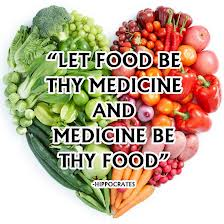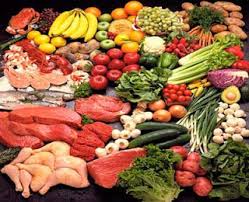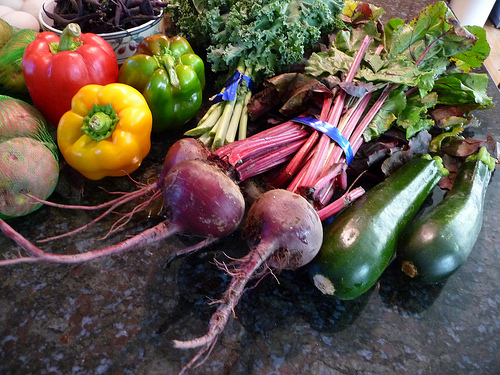Flavor Lies
How do we know what to eat?
 We come into this life hard-wired to seek calories in food for energy. And we naturally crave the substances that we need more of in our bodies. When we are deficient in water, we become thirsty. When we are deficient in salt, we crave salt. When our bodies need certain nutrients, we crave the foods we have learned to associate with those nutrients through experience.
We come into this life hard-wired to seek calories in food for energy. And we naturally crave the substances that we need more of in our bodies. When we are deficient in water, we become thirsty. When we are deficient in salt, we crave salt. When our bodies need certain nutrients, we crave the foods we have learned to associate with those nutrients through experience.
This nutritional learning can be seen in some food aversions. Have you ever had a meal, say, of seafood, then got sick? Later an association of the nausea and vomiting with the particular food, especially its smell, can turn the stomach again. And certainly you will not eat it.
Do you believe this? Can we trust our bodies’ cravings for nutrition, after all?
Can infants’ appetites be trusted?
In 1926, in Chicago, a pediatrician Dr. Clara Davis, MD conducted what could be the longest, most detailed and ambitious dietary experiment. And with 15 just-weaned infants! It was published as “RESULTS OF THE SELF-SELECTION OF DIETS BY YOUNG CHILDREN” in the Canadian Medical Association Journal in 1939.
 The premise was that the infants could eat whatever they wanted from an assortment of 34 foods, representing a wide range of both animal and vegetable foods that would adequately provide all the food elements, amino-acids, fats, carbohydrates, vitamins and minerals known to be necessary for human nutrition. It did not include sugar, butter, cheese or processed food.
The premise was that the infants could eat whatever they wanted from an assortment of 34 foods, representing a wide range of both animal and vegetable foods that would adequately provide all the food elements, amino-acids, fats, carbohydrates, vitamins and minerals known to be necessary for human nutrition. It did not include sugar, butter, cheese or processed food.
The infants ate everything at first randomly of all the foods presented, even tasting paper on the tray and chewing on the spoons. Their faces showed surprise, then shifted to either pleasure, indifference or dislike. Quickly they developed tastes and reached eagerly for some foods and neglected others. But these tastes changed suddenly and unpredictably. Nevertheless, in the long run, the infants chose a diet that was balanced.
The results of this study on the health of the 15 infants was that all had hearty appetites and grew and thrived. Even the 4 undernourished and the 5 with rickets regained their health through eating what they needed. No child had constipation. When a cold went around the unit, it was mild, lasting only 3 days. When the infants were growing, they tended to eat more protein, and ate less as the growth slowed. They chose foods that were therapeutic during colds and glandular fever.
This study magnificently shows that we associate nutrition with taste that we learn through experience. It refutes the idea that there is an inborn instinct pointing to the good or bad in food. And it shows that taste can lead us to optimal nutrition if we choose from a wide variety of whole, unprocessed and unadulterated foods. Even in 1939, Dr. Davis, MD recognized:
Appetite also appears to have fallibilities with processed foods which have lost some of their natural constituents and which have become such important features of modern diet, e.g., sugar and white flour. Certainly their introduction into previously sound primitive diets has invariably brought with it a train of nutritional evils, and their widespread excess in civilized diets is decried by nutritional authorities.
Is this what has happened today?
 Mark Schatzker has written a book documenting what has happened, called “The Dorito Effect – the surprising new truth about food and flavor. It contains lots of well-researched stories of things like the beginnings of Doritos, McCormick’s Technical Innovation Center, flavor forecasts, the amount of increase in food production in agriculture, functional MRIs showing “incentive salience,” plant secondary compounds, palatants, the chicken of the future, and nutritional confusion. It is a fast-paced read because of the fascinating stories, and is packed with information.
Mark Schatzker has written a book documenting what has happened, called “The Dorito Effect – the surprising new truth about food and flavor. It contains lots of well-researched stories of things like the beginnings of Doritos, McCormick’s Technical Innovation Center, flavor forecasts, the amount of increase in food production in agriculture, functional MRIs showing “incentive salience,” plant secondary compounds, palatants, the chicken of the future, and nutritional confusion. It is a fast-paced read because of the fascinating stories, and is packed with information.
Mr. Schatzker puts it this way:
Imagine for a moment, that foods are destinations on the highway of nutrition. The flavors are the highway signs – they are how a body knows where it is going – and the place they take you is the actual nutrition. Out there in nature, there’s a turnoff with a big sign above it that says grape. If you take that road you’ll get to a place with lots of vitamins c and k, some thiamin and riboflavin and potassium, fiber, sugar, and all manner of plant secondary compounds (phenolic acids, flavonoids, tannins, proanthocyanidins, and on it goes.) At the supermarket, the same sign – grape – takes your body to Gatorade, a place with no fiber and a bit of vitamin c, but that packs a serious hit of sugar.
High-Yield Agriculture leads to diluted food leads to chemical flavors
 The upshot of it is that, for the most part, flavor chemicals are added to just about everything because food is different now. Food formerly tasting good tastes bad when it is deficient in nutrients. And it is deficient because, in essence, it is diluted, tasting bland and watery. It got diluted by forcing agriculture to produce more per acre and for animals to grow bigger faster. Varieties of plants and animals are chosen for their ability to make a profit, and taste has gone down the tubes. So we add chemical flavors to everything.
The upshot of it is that, for the most part, flavor chemicals are added to just about everything because food is different now. Food formerly tasting good tastes bad when it is deficient in nutrients. And it is deficient because, in essence, it is diluted, tasting bland and watery. It got diluted by forcing agriculture to produce more per acre and for animals to grow bigger faster. Varieties of plants and animals are chosen for their ability to make a profit, and taste has gone down the tubes. So we add chemical flavors to everything.
There is a phone book of flavors called Allured’s Flavor and Fragrance Materials, and McCormick publishes a flavor forecast every year. These flavors are manufactured to make us want food even more. When regular food tastes bland, junk food seems more appealing because it tastes good. Then regular food becomes junk food when it is made palatable with these flavors.
The Cause of Obesity?
 This manufactured deliciousness, adding flavors to everything, makes us want it more. People’s eating habits resemble classic addictive behavior like smoking cigarettes, snorting cocaine, and shooting heroin. A JAMA study says:
This manufactured deliciousness, adding flavors to everything, makes us want it more. People’s eating habits resemble classic addictive behavior like smoking cigarettes, snorting cocaine, and shooting heroin. A JAMA study says:
Based on numerous parallels in neural functioning associated with substance dependence and obesity, theorists have proposed that addictive processes may be involved in the etiology of obesity.
Eating too much is an inability to satiate. By imposing flavors on foods without the corresponding nutrients, the foods are incapable of satiating our appetites. When food needs are met at multiple levels,we feel complete and satisfaction, not stuffed.
Flavors that Lie
Synthetic flavor technology not only breaks the connection between flavor and nutrition, it also confounds it. We eat something with a certain flavor, and the body expects certain nutrients, but the nutrients are not there. One example is artificial flavors. The body expects calories, and when they are not there craves more in an effort to bring in calories.
All processed foods are suspect. Read the labels and beware of the following:
These indicate the presence of chemicals that fool your nose:
- Natural flavor(s)
- Natural flavoring(s)
- Artificial flavor(s)
- Flavoring
- Flavor
These indicate the presence of chemicals that fool your tongue:
- Monosodium glutamate
- MSG
- Disodium guanylate
- Disodium inosinate
- Torula yeast
- Yeast extract
- Hydrolyzed protein
- Autolyzed yeast
- Saccharin (Sweet Twin, Sweet’N Low, Necta Sweet)
- Aspartame (Nutrasweet, Equal, Sugar Twin)
- Acesulfame potassium (Ace-K, Sunett, Sweet One)
- Sucralose (Splenda)
- Neotame (Newtame)
- Advantame
- Stevia
What to do?
 Real flavor is our salvation. No activity stimulates the human brain more than tasting. Start with foods from Farmer’s Markets, or grow your own. Look for food with flavor by finding heirloom varieties of fruits and vegetables. There are even varieties of chickens not sold in supermarkets.
Real flavor is our salvation. No activity stimulates the human brain more than tasting. Start with foods from Farmer’s Markets, or grow your own. Look for food with flavor by finding heirloom varieties of fruits and vegetables. There are even varieties of chickens not sold in supermarkets.
This probably means cooking for yourself from scratch and avoiding processed foods. I consider it a worthy pastime to prepare and eat tasty meals.
Please comment below about the tastiest food you have eaten and where you have found it.
WANT TO USE THIS ARTICLE IN YOUR NEWSLETTER OR WEB SITE? You can, as long as you include this complete blurb with it:
“Naturopathic Physician Dr. Cheryl Kasdorf is a doctor who listens and has answers with a natural approach that works. She is known as the go-to person to get back your get-up-and-go when it is gone, gone, gone. Get your FREE gift “Dr. Kasdorf’s Health Secrets for Feeling & Looking Great” at drcherylkasdorf.com



